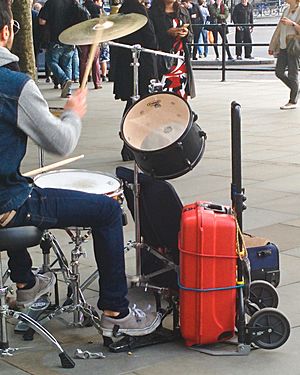Percussion instrument facts for kids

Percussion instruments are musical tools that make sounds when you hit, shake, or scrape them. There are many different types of percussion instruments. A person who plays them is called a percussionist. Percussionists often learn to play many different instruments because the basic skills are similar.
Some percussion instruments can play melodies and specific notes. These are known as tuned percussion. Examples include the xylophone, glockenspiel, vibraphone, tubular bells, and timpani.
Other percussion instruments do not play specific notes or melodies. They are called untuned percussion. Some common examples are the bass drum, snare drum, maracas, castanets, cymbals, tambourine, and claves.
In an orchestra, you might find more types of percussion instruments than in the other groups, like strings, woodwinds, or brass. However, older classical music didn't use much percussion. Composers like Mozart and Beethoven often only used the timpani. In the 19th century, more percussion instruments like cymbals, tambourines, and triangles were added. By the 20th century, some composers started using a very large number of percussion instruments in their music.
If a composer uses an unusual sound or object that isn't a string, woodwind, brass, or keyboard instrument, it's usually played by a percussionist. Sometimes, composers have even used things like typewriters, milk bottles, or vacuum cleaners in their musical pieces!
Contents
Types of Percussion Instruments
Percussion instruments can be grouped into different types based on their origin or how they are used. Here are a few examples:
- Latin percussion instruments: These are used in Latin American music. They include instruments like maracas, congas, and timbales.
- Classic percussion instruments: These are often found in orchestras. Examples are the timpani, bass drum, and xylophone.
- Modern percussion instruments: These are popular in genres like rock, pop, and jazz music. The drum kit is a great example, offering many different sounds. You can even add extra items like a cowbell or a tambourine to a drum kit.
The Drum Kit: A Percussion Powerhouse

The drum kit is a very important part of most pop, rock, and jazz music. A drum kit can include a bass drum, snare drum, tom-toms, cowbells, and different types of cymbals (like suspended cymbals and hi-hats).
In a jazz group, the drum kit works with the double bass to form the "rhythm section." A percussion player needs a very strong sense of rhythm. Other musicians depend on the percussionist to keep a steady beat and to play at the right volume so everyone can hear the melody.
Images for kids
-
Orchestral percussion section with timpani, unpitched auxiliary percussion and pitched tubular bells
-
Concussion idiophones (claves), and struck drums (conga drum)
-
Modern Japanese taiko percussion ensemble
-
Very large drum kit played by Terry Bozzio
-
Mridangam, an Indian percussion instrument, played by T. S. Nandakumar
-
Evelyn Glennie is a famous percussion soloist
-
Ancient Chinese musical bronze bells from the Eastern Zhou Dynasty, around 6th century BC.
See also
 In Spanish: Instrumento de percusión para niños
In Spanish: Instrumento de percusión para niños












